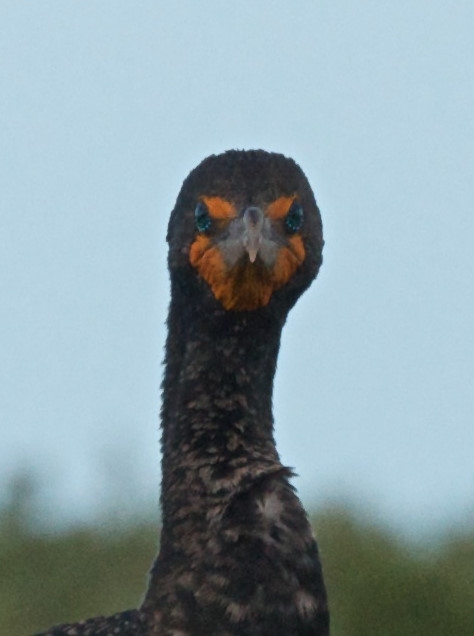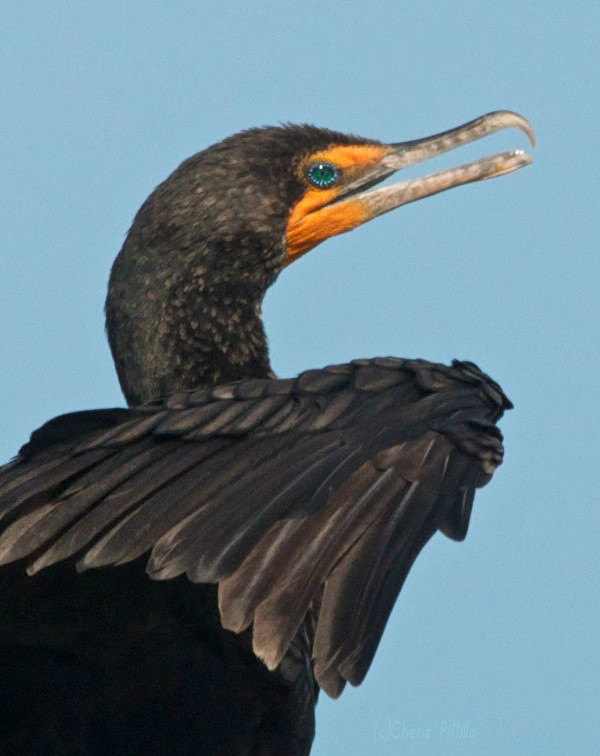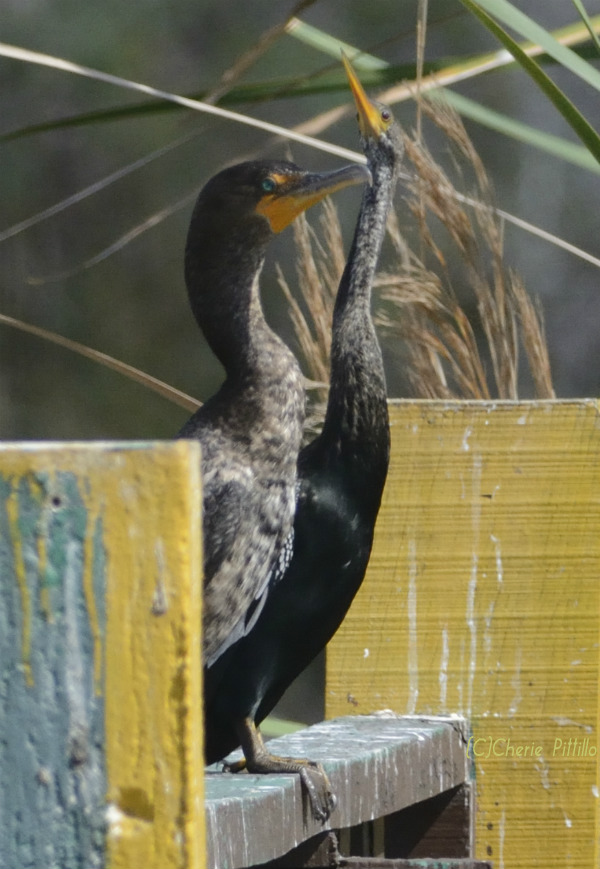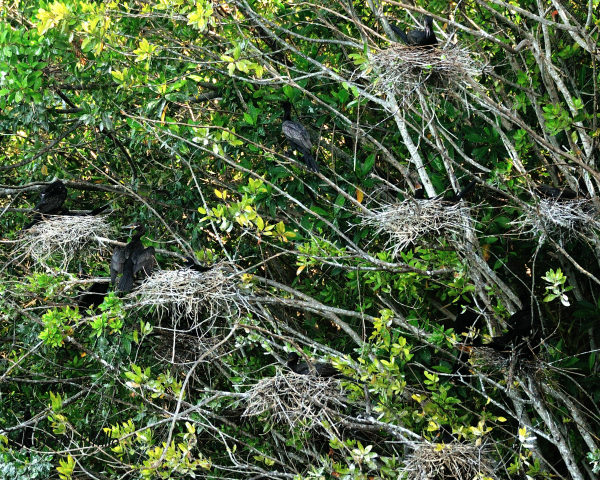When you see cormorants along the coast or at inland waters, you may observe them like this:
Often seen with outstretched wings to dry after diving, cormorants spend about half their time feeding and the other half loafing while perched on pilings, utility lines, rocks, trees, or sandbars. I wonder if two cormorants would be called a pair of loafers. Anyway, their wettable wings enable them to dive deeper than some other species.
But if you could take a closer look, perhaps you’d notice the aquamarine eyes of the adults…an appropriate color for a coastal bird.
And with intense inspection a bright blue throat lining would be quite a surprise! Sometimes exposing the lining threatens other cormorants to stay away from a nest or a perch and other times it’s to attract a female.
But wait, there’s more.
If you heard its call, it resembles low-pitched belches or pig grunts rather than a bird. Just listen:
Sound link: http://macaulaylibrary.org/audio/1997
In the Yucatan, the previous photos represent the two foot long, dark colored Double-crested Cormorant. The common name is misleading as a few flimsy feathery filaments form the double crest only during mating season. Even then the crest is difficult to see. By the way, immatures cormorants are lighter in color than the adults.
Another species lives in the Yucatan, the Neotropic Cormorant. References indicate the neotropic is smaller than the double-crested with a longer tail. Honestly, how am I supposed to distinguish between the two if I can only see one of the species?
In this case, Double-crested Cormorant has orange facial skin around its mouth and throat and in front of the eyes. The Neotropic has feathers in front of its eyes. Another realistic difference is white feathers at the distinct angular mouth corner of the neotropic. Those features can be seen with binocs.
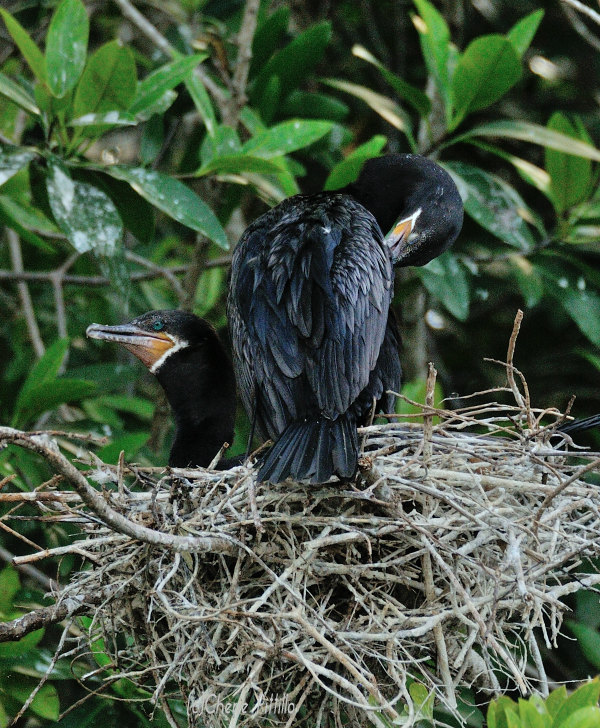
Nesting pair of Neotropic Cormorants; notice feathers in front of eye, and white feathers at mouth and throat
While the double-crested feeds mainly on fish, it may also dine on eels, crustaceans, amphibians. Supposedly the neotropic may hunt cooperatively for fish and also may eat insects and frogs.
Both species swallow their food whole and regurgitate pellets of fish bones, scales, and other undigestible parts.
For more than a thousand years, fishermen continue to use cormorants (ukai) to catch fish in Japan, China and other countries for their livelihood. A fisherman attaches a leash to the cormorant and also a ring around its neck. The bird dives into water and goes fishing. While the bird can eat smaller fish, larger fish are trapped in its neck. Then the fisherman pulls on the leash, retrieves the bird, and removes the whole fish. Today, this process seems to appeal more to tourists.
On its own, the cormorant captures its prey with the help of its hook-tipped bill.
I’m often asked the difference between a cormorant and Anhinga (aka snake bird, water turkey). The Anhinga’s thin bill acts like a spear and lacks a hooked tip as seen in this image.
I want to look at that common name again. Who would have thought that a bird’s common name would contain a word that describes how people in the US and Canada react to it?
Rant.
As a gregarious, colonial nesting/roosting bird, its voracious appetite for fish impacts commercial fisheries and aquaculture farms. With orders by governmental departments, thousands have been killed in the US and Canada. Also thousands may roost or nest together in trees which eventually fall. Vegetation below their roosts or nests becomes whitewashed with excrement and are unusable by other species. Rotting fish odor permeates the area.
On the other hand, in Florida, racks catch the guano for fertilizer. I guess that would be a rave versus all the rants.
GO OUTDOORS AND RAVE ABOUT NATURE.
Mentioned Species:
Double-crested Cormorant Phalacrocorax auritus, Cormóran Orejón (Spanish) Mach (Mayan)
Neotropic Cormorant Phalacrocorax brasilianus, Cormóran Oliváceo (Spanish) Mach (Mayan)
Anhinga, Anhinga anhinga, Anhinga Americano (Spanish), Chowak kaa (Mayan)
DISCLAIMER: References do not agree on details about these species. Here are my resources: http://bna.birds.cornell.edu/bna/species/441/articles/introduction? http:neotropical.birds.cornell.edu/portal/species/overview?, Sal a Pajarear Yucatan Guia de Aves, A Guide to the Birds of Mexico and Northern Central America, Birds and Reserves of the Yucatan Peninsula, http://macaulaylibrary.org/ a website from Cornell Lab of Ornithology, Lives of North American Birds, https://www.allaboutbirds.org/guide/,The Birder’s Handbook, A Field Guide to the Natural History of North American Birds, The Audubon Society Master Guide to Birding 1, Birds of the Carolinas, The Armchair Birder Goes Coastal, Florida Bird Live, The Marsh and Lagoon Birds of the Lowcountry, http://www.euppublishing.com/doi/abs/10.3366/anh http://www.theatlantic.com/china/archive/2013/07/catching-fish-using-birds-stunning-images-of-a-dying-art-in-china/277798/winged fishermen’ fish-seeking missile, http://www.japan-guide.com/e/e2426.html, http://www.theguardian.com/artanddesign/gallery/2014/jul/11/cormorant-fishing-in-japan-in-pictures
Cherie Pittillo, “nature inspired,” photographer and author, explores nature everywhere she goes. She’s identified 56 bird species in her Merida, Yucatan backyard view. Her column, published on the 7th and 21st of each month, features anecdotes about birding in Merida, Yucatan and beyond. Contact: [email protected] All rights reserved, ©Cherie Pittillo


